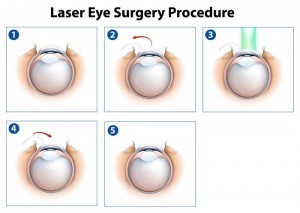LASIK ….by the Bubble
If you are someone who has dealt with visual difficulties, more than likely you have researched ways to correct your vision without the use of glasses or contact lenses.
LASIK or Lasik (laser-assisted in situ keratomileuses) is more commonly known as laser eye surgery. Lasik is a refractory procedure performed by an ophthalmologist to correct myopia, hyperopia, and astigmatism. A laser or microkeratome is used to reshape the cornea with the intended result of improving visual acuity.
Reshaping the Cornea
There are a variety of ways in which the ophthalmologist may choose to expose the cornea during a Lasik procedure.
He may choose to use a microkeratome to cut a flap, prk method rubbing epithelial cells of the ocular surface, or gas bubbles to create a flap. The way your eye surgeon chooses to expose the cornea is individual in that every patient is different.
• Microkeratome. A microkeratome is a precision surgical instrument with an oscillating blade that is used to create the flap during a Lasik procedure. A suction ring is placed over the eye and a microkeratome is used to create a flap. The flap is moved to the side and the laser is then used to reshape the cornea. The flap is then replaced and allowed to adhere on its own.
• PRK. Photorefractive keratotomy (PRK) differs from the Lasik procedure. Rather than using a microkeratome to create a flap, with PRK the entire epithelial surface of the cornea is removed and no flap is created. One laser is utilized for reshaping purposes.
For many patients, the idea of having a blade utilized for any type of surgical procedure is stressful enough; however, the utilization of a blade for the eye area can be particularly disconcerting.
Bladeless Lasik eye surgery is a viable option for patients who have given thought to have corrective vision surgery but were less than enthused about blades being involved.

With bladeless Lasik eye surgery, tiny laser pulses of light pass through the outer portion of the cornea. Underneath, a uniform layer of bubbles is formed just beneath the surface of the eye.
The dimension of the layer of bubbles is determined by the surgeon and will vary for each patient’s specific eye anatomy. This bubble flap creation is computer-controlled for optimum precision. The flap creation process takes approximately 20 seconds, with a total of 10 minutes for the entire Lasik procedure. For the Lasik procedure, the surgeon simply lifts the flap and performs the procedure.
Upon completion, the flap that was created using the bubble technique is allowed to lock back into place. At this point, the eyes start to rapidly heal. What is most important to many patients is that the bubbles are not painful and there is no scarring after the procedure.
Lasik Evaluation
Before your procedure, you will meet with a coordinator or eye surgeon who will discuss what to expect during and after the procedure. At this time, your medical history will be discussed and a complete assessment of your eyes will be done. The coordinator or eye surgeon will measure the thickness of your cornea, corneal mapping, refraction, and your pupils will be dilated. After this initial assessment, your eye surgeon will discuss with you his plan, address any concerns that you may have, and answer questions. Once this has been completed, you can schedule a date for your Lasik procedure.

There are many myths surrounding Lasik eye surgery. The biggest myth is that there is a lot of pain involved or that the procedure itself is very scary. The best way to put to bed any fears about Lasik eye surgery is to do your research.
Educate yourself on the various types of procedures that are available for vision improvement. Make an appointment with a highly-qualified eye surgeon to find out which Lasik procedure is a good fit for you. By taking these steps, you will find yourself seeing clearly in less time than you thought possible.

